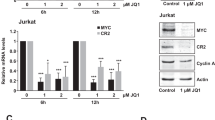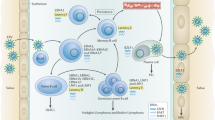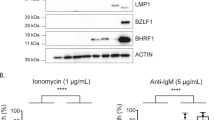Abstract
Epstein–Barr virus (EBV)-associated Burkitt’s lymphoma is characterised by the deregulation of c-Myc expression and a restricted viral gene expression pattern in which the EBV nuclear antigen-1 (EBNA1) is the only viral protein to be consistently expressed. EBNA1 is required for viral genome propagation and segregation during latency. However, it has been much debated whether the protein plays a role in viral-associated tumourigenesis. We show that the lymphomas which arise in EµEBNA1 transgenic mice are unequivocally linked to EBNA1 expression and that both C-Myc and Mdm2 deregulation are central to this process. Tumour cell survival is supported by IL-2 and there is a skew towards CD8-positive T cells in the tumour environment, while the immune check-point protein PD-L1 is upregulated in the tumours. Additionally, several isoforms of Mdm2 are upregulated in the EµEBNA1 tumours, with increased phosphorylation at ser166, an expression pattern not seen in Eµc-Myc transgenic tumours. Concomitantly, E2F1, Xiap, Mta1, C-Fos and Stat1 are upregulated in the tumours. Using four independent inhibitors of Mdm2 we demonstrate that the EµEBNA1 tumour cells are dependant upon Mdm2 for survival (as they are upon c-Myc) and that Mdm2 inhibition is not accompanied by upregulation of p53, instead cell death is linked to loss of E2F1 expression, providing new insight into the underlying tumourigenic mechanism. This opens a new path to combat EBV-associated disease.
This is a preview of subscription content, access via your institution
Access options
Subscribe to this journal
Receive 50 print issues and online access
$259.00 per year
only $5.18 per issue
Buy this article
- Purchase on Springer Link
- Instant access to full article PDF
Prices may be subject to local taxes which are calculated during checkout








Similar content being viewed by others
References
Sivachandran N, Thawe NN, Frappier L. Epstein-Barr virus nuclear antigen 1 replication and segregation functions in nasopharyngeal carcinoma cell lines. J Virol. 2011;85:10425–30.
Canaan A, Haviv I, Urban AE, Schulz VP, Hartman S, Zhang Z, et al. EBNA1 regulates cellular gene expression by binding cellular promoters. Proc Natl Acad Sci USA. 2009;106:22421–6.
Deschamps T, Quentin B, Leske DM, MacLeod R, Mompelat D, Tafforeau L. Epstein-Barr Virus Nuclear Antigen 1 aEBNA1a interacts with Regulator of Chromosome Condensation aRCC1a dynamically throughout the cell cycle. J Gen Virol. 2017;98:251–265.
Malik-Soni N, Frappier L. Proteomic profiling of EBNA1-host protein interactions in latent and lytic Epstein-Barr virus infections. J Virol. 2012;86:6999–7002.
Gnanasundram SV, Pyndiah S, Daskalogianni C, Armfield K, Nylander K, Wilson JB, Fåhraeus R. PI3Kδ activates E2F1 synthesis in response to mRNA translation stress. Nat Commun. 2017;8:2103. in press
Wilson JB, Bell JL, Levine AJ. Expression of Epstein-Barr virus nuclear antigen-1 induces B cell neoplasia in transgenic mice. EMBO J. 1996;15:3117–26.
Kennedy G, Komano J, Sugden B. Epstein-Barr virus provides a survival factor to Burkitt’s lymphomas. Proc Natl Acad Sci USA. 2003;100:14269–74.
Saridakis V, Sheng Y, Sarkari F, Holowaty MN, Shire K, Nguyen T, et al. Structure of the p53 binding domain of HAUSP/USP7 bound to Epstein-Barr nuclear antigen 1 implications for EBV-mediated immortalization. Mol Cell. 2005;18:25–36.
O’Neil JD, Owen TJ, Wood VH, Date KL, Valentine R, Chukwuma MB, et al. Epstein-Barr virus-encoded EBNA1 modulates the AP-1 transcription factor pathway in nasopharyngeal carcinoma cells and enhances angiogenesis in vitro. J Gen Virol. 2008;89:2833–42.
Owen TJ, O’Neil JD, Dawson CW, Hu C, Chen X, Yao Y, et al. Epstein-Barr virus-encoded EBNA1 enhances RNA polymerase III-dependent EBER expression through induction of EBER-associated cellular transcription factors. Mol Cancer. 2010;9:241.
Wood VH, O’Neil JD, Wei W, Stewart SE, Dawson CW, Young LS. Epstein-Barr virus-encoded EBNA1 regulates cellular gene transcription and modulates the STAT1 and TGFbeta signaling pathways. Oncogene. 2007;26:4135–47.
Tempera I, De Leo A, Kossenkov AV, Cesaroni M, Song H, Dawany N, et al. Identification of MEF2B, EBF1, and IL6R as direct gene targets of Epstein-Barr Virus (EBV) nuclear antigen 1 critical for EBV-infected B-lymphocyte survival. J Virol. 2015;90:345–55.
Drotar ME, Silva S, Barone E, Campbell D, Tsimbouri P, Jurvansu J, et al. Epstein-Barr virus nuclear antigen-1 and Myc cooperate in lymphomagenesis. International journal of cancer. J Int du Cancer. 2003;106:388–95.
Wilson JB, Levine AJ. The oncogenic potential of Epstein-Barr virus nuclear antigen 1 in transgenic mice. Curr Top Microbiol Immunol. 1992;182:375–84.
Tsimbouri P, Al-Sheikh Y, Drotar ME, Cushley W, Wilson JB. Epstein-Barr virus nuclear antigen-1 renders lymphocytes responsive to IL-2 but not IL-15 for survival. J Gen Virol. 2008;89:2821–32.
Tsimbouri P, Drotar ME, Coy JL, Wilson JB. bcl-xL and RAG genes are induced and the response to IL-2 enhanced in EµEBNA-1 transgenic mouse lymphocytes. Oncogene. 2002;21:5182–7.
Boyman O, Sprent J. The role of interleukin-2 during homeostasis and activation of the immune system. Nat Rev Immunol. 2012;12:180–90.
Li DQ, Divijendra Natha Reddy S, Pakala SB, Wu X, Zhang Y, Rayala SK, et al. MTA1 coregulator regulates p53 stability and function. J Biol Chem. 2009;284:34545–52.
Okoro DR, Rosso M, Bargonetti J. Splicing up mdm2 for cancer proteome diversity. Genes Cancer. 2012;3:311–9.
Schuster K, Fan L, Harris LC. MDM2 splice variants predominantly localize to the nucleoplasm mediated by a COOH-terminal nuclear localization signal. Mol Cancer Res. 2007;5:403–12.
Zheng T, Wang J, Zhao Y, Zhang C, Lin M, Wang X, et al. Spliced MDM2 isoforms promote mutant p53 accumulation and gain-of-function in tumorigenesis. Nat Commun. 2013;4:2996.
Rosso M, Okoro DE, Bargonetti J. Splice variants of MDM2 in oncogenesis. Subcell Biochem. 2014;85:247–61.
Bill KL, Garnett J, Meaux I, Ma X, Creighton CJ, Bolshakov S, et al. SAR405838: a novel and potent inhibitor of the MDM2:p53 axis for the treatment of dedifferentiated liposarcoma. Clin Cancer Res. 2016;22:1150–60.
Wade M, Li YC, Wahl GM. MDM2, MDMX and p53 in oncogenesis and cancer therapy. Nat Rev Cancer. 2013;13:83–96.
Gu L, Zhang H, Liu T, Zhou S, Du Y, Xiong J, et al. Discovery of dual inhibitors of MDM2 and XIAP for cancer treatment. Cancer Cell. 2016;30:623–36.
Zhang H, Gu L, Liu T, Chiang KY, Zhou M. Inhibition of MDM2 by nilotinib contributes to cytotoxicity in both Philadelphia-positive and negative acute lymphoblastic leukemia. PLoS ONE. 2014;9:e100960.
Kojima K, Burks JK, Arts J, Andreeff M. The novel tryptamine derivative JNJ-26854165 induces wild-type p53- and E2F1-mediated apoptosis in acute myeloid and lymphoid leukemias. Mol Cancer Ther. 2010;9:2545–57.
Renouf B, Hollville E, Pujals A, Tetaud C, Garibal J, Wiels J. Activation of p53 by MDM2 antagonists has differential apoptotic effects on Epstein-Barr virus (EBV)-positive and EBV-negative Burkitt’s lymphoma cells. Leukemia. 2009;23:1557–63.
Kang MS, Lu H, Yasui T, Sharpe A, Warren H, Cahir-McFarland E, et al. Epstein-Barr virus nuclear antigen 1 does not induce lymphoma in transgenic FVB mice. Proc Natl Acad Sci USA. 2005;102:820–5.
Goodman A, Patel SP, Kurzrock R. PD-1-PD-L1 immune-checkpoint blockade in B-cell lymphomas. Nat Rev Clin Oncol. 2017;14:203–20.
Xie N, Ma L, Zhu F, Zhao W, Tian F, Yuan F, et al. Regulation of the MDM2-p53 pathway by the nucleolar protein CSIG in response to nucleolar stress. Sci Rep. 2016;6:36171.
Zhang Z, Wang H, Li M, Rayburn ER, Agrawal S, Zhang R. Stabilization of E2F1 protein by MDM2 through the E2F1 ubiquitination pathway. Oncogene. 2005;24:7238–47.
Tian X, Chen Y, Hu W, Wu M. E2F1 inhibits MDM2 expression in a p53-dependent manner. Cell Signal. 2011;23:193–200.
Volk EL, Fan L, Schuster K, Rehg JE, Harris LC. The MDM2-a splice variant of MDM2 alters transformation in vitro and the tumor spectrum in both Arf- and p53-null models of tumorigenesis. Mol Cancer Res. 2009;7:863–9.
Zimber-Strobl U, Strobl L, Hofelmayr H, Kempkes B, Staege MS, Laux G, et al. EBNA2 and c-myc in B cell immortalization by Epstein-Barr virus and in the pathogenesis of Burkitt’s lymphoma. Curr Top Microbiol Immunol. 1999;246:315–20. discussion 321
Wilson JB, Drotar ME. Considerations in generating transgenic mice. DNA, RNA, and protein extractions from tissues--rapid and effective blotting. Methods Mol Biol. 2001;174:361–77.
Hannigan A, Wilson JB. Evaluation of LMP1 of Epstein-Barr virus as a therapeutic target by its inhibition. Mol Cancer. 2010;9:184.
Achilli F, Boyle S, Kieran D, Chia R, Hafezparast M, Martin JE, et al. The SOD1 transgene in the G93A mouse model of amyotrophic lateral sclerosis lies on distal mouse chromosome 12. Amyotroph Lateral Scler Other Mot Neuron Disord. 2005;6:111–4.
Croft JA, Bridger JM, Boyle S, Perry P, Teague P, Bickmore WA. Differences in the localization and morphology of chromosomes in the human nucleus. J Cell Biol. 1999;145:1119–31.
Acknowledgements
Thanks to Daniela Quintana for contribution to cloning the line 26 junctional sequences, Goutham Subramanain for contribution to characterising the Rab28 genome region sequences in the line 26 and Maria Jackson who contributed to construction of the dnEBNA1 plasmids.
Author contributions
SA conducted FACS experiments, western analyses and drug assays, YA-S cloned the line 59 transgene and contributed to FISH, DC and MD contributed to mouse work and cloning the line 26 transgene, AH conducted the dnEBNA1 analyses, SB supervised and analysed the FISH experiment, PH, AK and PL contributed to the RNA data (array and seq) analyses, KA contributed to the drug analyses, MB conducted the PD-L1 analysis, PT contributed to transgene cloning, the array experiment and mouse work. JBW devised, supervised and procured funding for the study and wrote the manuscript.
Funding
Funding contribution to the work includes former LRF (now Bloodwise) grants. AH was supported by a Wellcome Trust PhD studentship while at GU, KA is supported by a PhD BBSRC studentship. SA is, and YA was, supported by Saudi Arabian PhD scholarships.
Author information
Authors and Affiliations
Corresponding author
Ethics declarations
Conflict of interest
The authors declare that they have no conflict of interest.
Electronic supplementary material
Rights and permissions
About this article
Cite this article
AlQarni, S., Al-Sheikh, Y., Campbell, D. et al. Lymphomas driven by Epstein–Barr virus nuclear antigen-1 (EBNA1) are dependant upon Mdm2. Oncogene 37, 3998–4012 (2018). https://doi.org/10.1038/s41388-018-0147-x
Received:
Revised:
Accepted:
Published:
Issue Date:
DOI: https://doi.org/10.1038/s41388-018-0147-x
This article is cited by
-
Latency and lytic replication in Epstein–Barr virus-associated oncogenesis
Nature Reviews Microbiology (2019)
-
Triptolide inhibits Epstein-Barr nuclear antigen 1 expression by increasing sensitivity of mitochondria apoptosis of nasopharyngeal carcinoma cells
Journal of Experimental & Clinical Cancer Research (2018)



